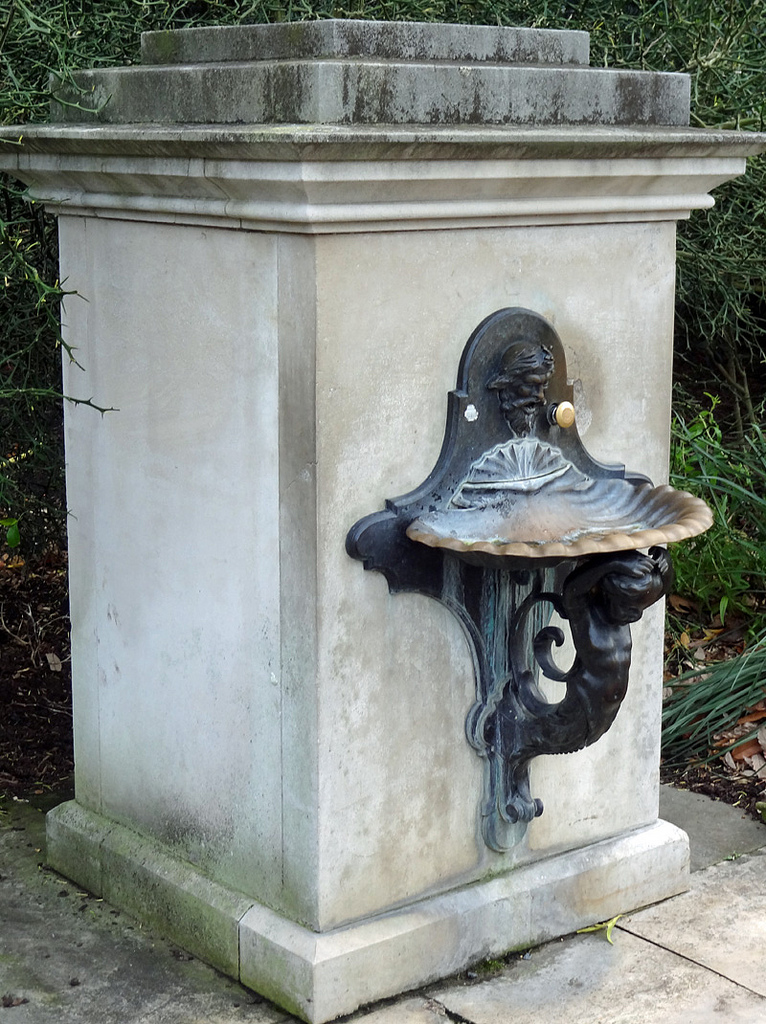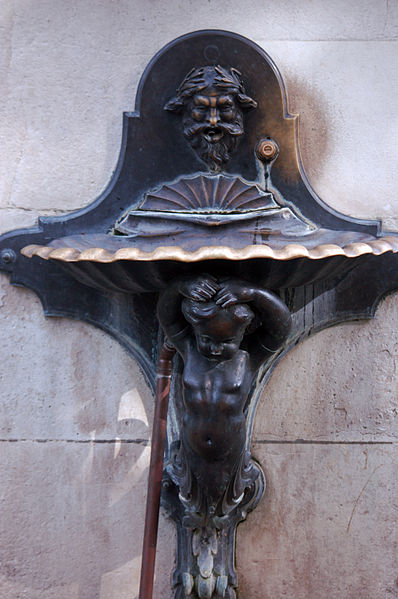Location: Harlesden, London, England
Known as the Clock Tower this structure located in the High Street was originally also a drinking fountain. It was erected in 1888 to commemorate Queen Victoria’s Golden Jubilee which had been celebrated a year earlier.
With the advent of the motor vehicle it became a traffic hazard; at least two trams derailed and collided with the clock which resulted in one of the four decorative arms being damaged. As a result, on 20th March 1939 the Clock Tower was relocated three metres from its original position to ease navigation in the area.

The basins no longer appear on images of this time period.
 The shape of the lanterns has changed and they no longer have crown terminals. Possibly due to the transition to electric light.
The shape of the lanterns has changed and they no longer have crown terminals. Possibly due to the transition to electric light.
 The image above shows that the lamps have been replaced again. The shape has changed and the glass is now frosted/opaque.
The image above shows that the lamps have been replaced again. The shape has changed and the glass is now frosted/opaque.

The image above is from the 1950’s era. The lamps no longer exist and the structure has been painted red.
Circa 60s -70s and there is no weather vane visible.
The Jubilee Clock was recorded as a Grade II listed building on 23 Jan 1974. The tower was renovated in 1992 and again in 1997 when it was painted red, gold and black.
In 2014 the structure was temporarily removed as part of a £4.5 million regeneration project of the town centre. The Jubilee Clock, refurbished in its original colour scheme, was unveiled on 14 February 2015 at the new semi-pedestrian section of the High Street.

The original structure manufactured by Steven Bros & Co. of London and Glasgow was seated on a square plinth with two dog troughs at ground level. Two large demi-lune basins protruded from the pedestal beneath which a dedication was inscribed: Erected by public subscription A.D. 1887. Directly above was the maker’s nameplate, Steven Bros. & Co. London & Glasgow.

Status 2006
An additional dedication on the base presumably refers to members of the committee that managed the project; C. J. Class Esq. Chairman / John Soper Esq. Treasurer / C. Coldney-Cary Esq. Sub / Jas Maxwell Esq. Committee / Wm. Orme Wedlake Esq. / Hon. Secretary

Four dolphins at each corner of the stanchion created sections decorated with a shell pattern, floral relief and a crest above which were a crown and two rosettes. Two drinking cups were suspended on chains.
The capital supported a fluted lamp pillar with attic base. The pillar was decorated with swags, a shield bearing a cross and stylized flowers flanked by leaves. Four consoles offered a gas light source from a glass paned lantern the top of which was decorated with palmette relief and a terminal resembling castle turrets.
Four beaded consoles divided by a flower sat just beneath the four clock faces. Each clock panel was bound by fan spandrels. A gable roof was adorned by a spike at each peak and bas-relief of a crown in the pediment.
A closed urn with 4 knob pendants originally supported a weather vane with directional compass points and a directional arrow with butterfly wings.
Note of thanks and appreciation: I would like to acknowledge John Bolton from the Scottish Ironwork Foundation who brought my attention to this structure and who has been a welcome, boundless, source of information and assistance on many of my posts on items manufactured by Scottish Iron Foundries.
Glossary:
- Attic base, a column base with two rings
- Bas-relief, sculpted material that has been raised from the background to create a slight projection from the surface
- Capital, the top of a column that supports the load bearing down on it
- Console, a decorative bracket support element
- Demi-lune, half moon or crescent shape
- Fluted, a long rounded groove
- Gable, triangular portion of a wall between edges of a dual pitched roof
- Palmette, a decorative motif resembling the fan shaped leaves of a palm tree
- Pedestal, an architectural support for a column or statue
- Pediment, an element in architecture consisting of a gable placed above a horizontal structure supported by columns
- Plinth, flat base usually projecting, upon which a pedestal, wall or column rests.
- Rosette, a round stylized flower design
- Spandrel, the triangular space between two arches
- Stanchion, upright bar, post or frame providing support
- Terminal, statue or ornament that stands on a pedestal












 The image above shows that the lamps have been replaced again. The shape has changed and the glass is now frosted/opaque.
The image above shows that the lamps have been replaced again. The shape has changed and the glass is now frosted/opaque.














